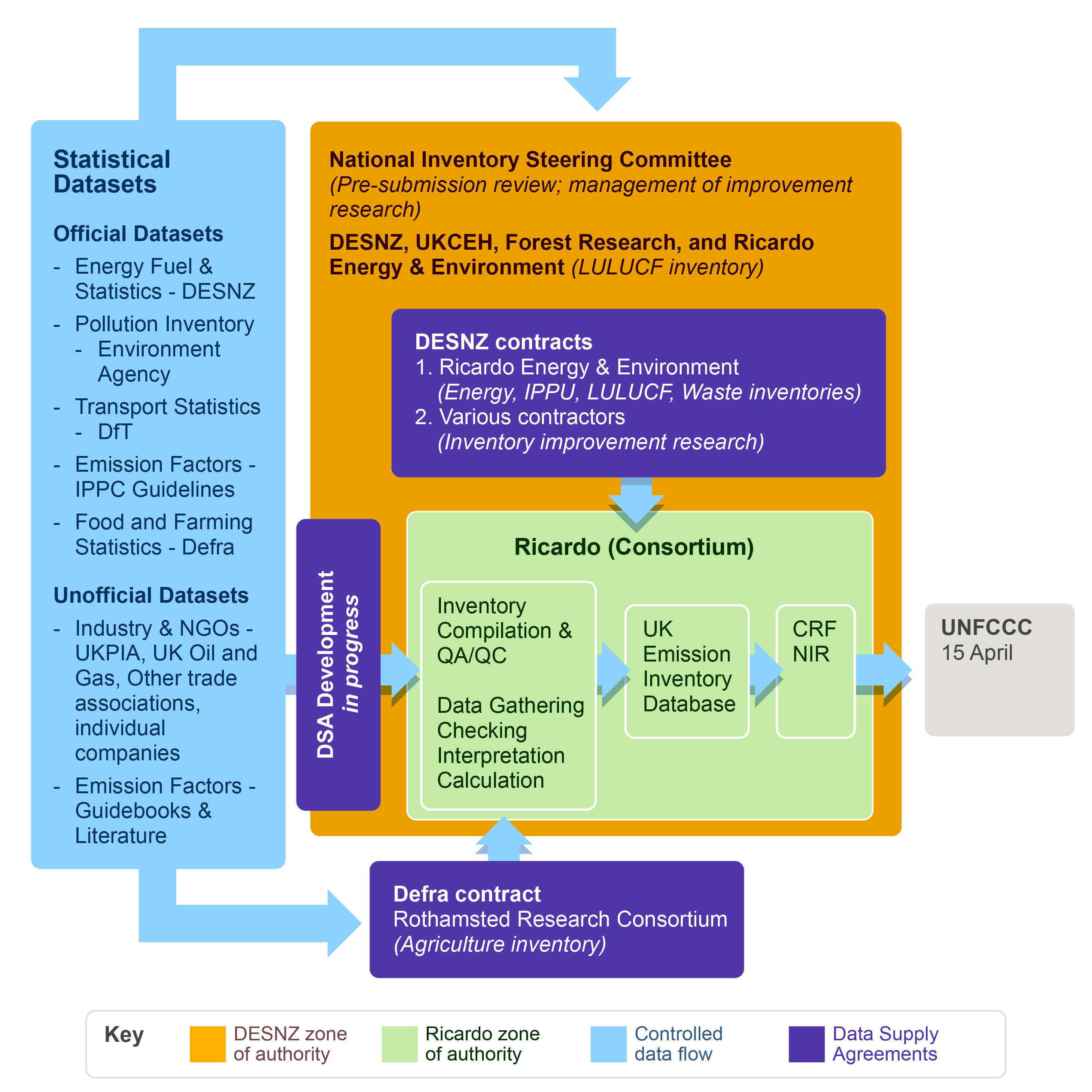- NAEI
- About the inventory
- National inventory system
National inventory system
The National Inventory System applies to the Greenhouse Gas Inventory only. This page contains information split into various sections, you can jump directly to a section using the links below.
Introduction
The National Inventory System (NIS) is a requirement of the GHG Inventory only. However, the benefits of the system apply to the AQ inventory also. The Marrakesh Accords of the Kyoto Protocol (Decision 20/CP7) define the requirements for National Inventory Systems (NIS), including the need to establish legal, procedural and institutional arrangements to ensure that all parties to the Protocol estimate and report their GHG emissions in accordance with relevant decisions of the COP, facilitate UNFCCC Reviews and improve the quality of their inventories. Under related EU legislation set out in Decision 280/2004/EC, the UK was required to have in place it's NIS by 31st December 2005.
The development of more formal agreements between BEIS and Key Data Providers (KDPs) is ongoing and a number of formal Data Supply Agreements (DSAs) are now in place.
The figure below shows the main elements in the UK NIS. BEIS is the Single National Entity responsible for submitting the UK's GHGI to the UNFCCC. Ricardo Energy & Environment compiles the GHGI on behalf of BEIS, and produces disaggregated estimates for the Devolved Administrations within the UK.
Key Data Providers include other Government Departments such as Department for Environment, Food and Rural Affairs (Defra) and the Department for Transport (DfT), Non-Departmental Public Bodies such as the Environment Agency for England (EA), Natural Resources Wales (NRW), the Northern Ireland Environment Agency and the Scottish Environment Protection Agency (SEPA), private companies such as Tata Steel, and business organisations such as UK Petroleum Industry Association (UKPIA) and the Mineral Products Association (MPA).

The organisational Structure of the UK NIS can be summarised as follows:

Single National Entity: BEIS
As the designated Single National Entity for the UK GHG NIS, BEIS has the following roles and responsibilities:
National Inventory System Management & Planning
- Chair of NISC and management of the Improvement Programme
- Overall control of the NIS development & function
- Management of contracts & delivery of GHGI
- Definition of performance criteria for NIS key organisations
Development of Legal & Contractual Infrastructure
- Review of legal & organisational structure
- Implementation of legal instruments and contractual developments as required to meet guidelines
Inventory Agency: Ricardo Energy & Environment
As the designated Inventory Agency for the UK GHG NIS, Ricardo Energy & Environment has the following roles and responsibilities:
Planning
- Co-ordination with BEIS to deliver the NIS
- Review of current NIS performance and assessment of required development action
- Scheduling of tasks and responsibilities to deliver GHG inventory and NIS
Preparation
- Drafting technical schedules to Data Supply Agreements with key data providers
- Review of source data & identification of developments required to improve GHG inventory data quality
Management
- Documentation & archiving
- Dissemination of information regarding NIS to KDPs
- Management of inventory QA/QC plans, programmes and activities
Inventory compilation
- Data acquisition, processing and reporting
- Delivery of NIR (including associated CRF tables) to time and quality
Key data providers
Within the UK GHG NIS, organisations that are Key Data Providers have the following roles and responsibilities:
Data Quality, Format, Timeliness, Security
- Delivery of source data in appropriate format and in time for inventory compilation, allowing for all required QA/QC procedures by the Inventory Agency
- Management of their data acquisition, processing & reporting systems, taking regard for QA/QC requirements and responding to Inventory Agency requests for clarifications
- Identification of any required organisational or legal development and resources to meet more stringent NIS data requirements, notably the security of data provision in the future
- Communication with BEIS, Ricardo Energy & Environment and their peers / members to help to disseminate information regarding the GHG inventory and National System
Summary of key data sources
Energy statistics required for compilation of the NAEI are obtained from the Digest of UK Energy Statistics (DUKES). DUKES is compiled and published by the Department for Business, Energy & Industrial Strategy (BEIS). DUKES is available on the BEIS website.
Information on industrial processes is provided either directly to Ricardo Energy & Environment by the individual plant operators or from:
- The Environment Agency's Pollution Inventory (PI) for England
- Natural Resource Wales' Pollution Inventory (PI)
- The Scottish Environmental Protection Agency’s Scottish Pollutant Release Inventory (SPRI)
- The Northern Ireland Environment Agency’s Inventory of Statutory Releases (ISR)
Reporting annual emission estimates to these UK inventories is a statutory requirement for industrial operators of installations regulated under the Integrated Pollution Prevention and Control (IPPC) regulations and Environmental Permitting Regulations (EPR). The data from these inventory sources is also used to quality check data provided by companies directly to Ricardo Energy & Environment.
The Rothamsted Research consortium compiles the inventory for agricultural emissions using agricultural statistics from Defra and the Devolved Administrations.
The UK Centre for Ecology and Hydrology (UKCEH) compiles estimates of emissions and removals from LULUCF using land-use data and information on forestry from the Forestry Commission (a non-departmental public body), Government Departments and from other sources.
Both BEIS and Defra also fund periodic research contracts to provide emission estimates for certain sources such as fluorinated gases and landfill methane and to provide estimates for previously unreported emission sources.
Page last modified: 24 October 2023
